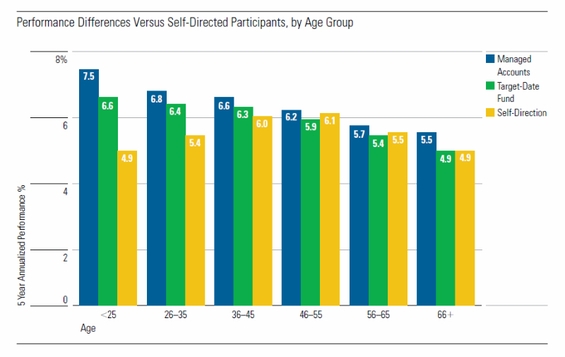Historical performance is generally one of the first things employers consider, or ask about, when selecting their plans’ default investments. While these inquiries are well-intentioned, performance comparisons can be, at best, slightly misleading and, at worst, very misleading.
For example, if one target-date fund outperforms another, it doesn’t mean that it’s better. The outperforming target-date fund could have taken on considerably more risk to achieve the higher performance, and actually underperformed on a risk-adjusted basis.
What drives a default investment’s performance
Understanding the drivers of the performance of multi-asset portfolios is complex. It generally requires looking across multiple categories, including but not limited to: the overall portfolio equity allocation (i.e., glide path); the sub-asset class allocations (i.e., style exposures); and the investment implementation vehicles (e.g., active versus passive).
This performance question gets even trickier when attempting to contrast target-date funds and managed accounts. For example, there are significantly more potential portfolio options in managed accounts. These options can vary not only across plans, but also across participants. Plans can have different core investment menus. And it’s possible a participant with the same equity allocation target may have a different portfolio based on his or her age or other characteristics.
While comparing target-date funds is already a difficult exercise, comparing target-date funds to managed accounts is even more complex. And often, it’s not likely to yield meaningful results.
What performance data can show for default investments
While historical performance is not necessarily a valid metric of the respective benefits of managed accounts and target-date funds, research does suggest that managed accounts have outperformed target date-funds—even after accounting for higher fees.
The graph below includes a historical five-year annualized performance comparison for target-date fund users, managed account users, and participants self-directing their accounts by group. All performance numbers are net of all fees, which means the managed accounts performance includes the additional costs associated with the service.

Why professionally managed default investments should be considered
The most important takeaway from the graph above is that both managed accounts and target-date fund investors have outperformed participants who are self-directing, especially for younger participants.
In other words, encouraging participants to consider some type of professionally managed solution can be incredibly important. This difference was especially notable for younger participants, who likely had considerably more conservative portfolios when self-directing. Overall, the average outperformance, which is weighted by the number of participants within each age group, was 48 basis points for those in managed accounts versus those who were self-directing, and 24 basis points for those in managed accounts versus those who in a target-date fund.
The performance differences noted by Advised Asset Group are similar to past findings from Financial Engines in 2014, where both managed accounts and target-date fund investors significantly outperformed investors who were self-directing.
Managed accounts participants were also noted to outperform target-date fund investors by approximately 50 basis points, on average. Overall though, professionally managed investment solutions, such as target-date funds and managed accounts, often resulted in higher returns compared with self-directing. This speaks to the importance of encouraging participants to consider the respective default investments and to stay in it—what I call the “stickiness” of the solution.
In my next post, I’ll take a look at other factors to consider when choosing default investments, including the stickiness of the solution.
Please see below for important disclosure.


